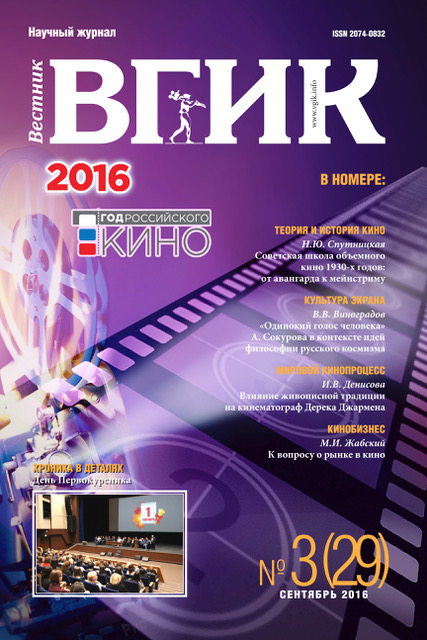Indian Cinema: Past and Present
- Authors: Nefedova D.N1
-
Affiliations:
- ФГБОУ ВО «Самарский государственный институт культуры»
- Issue: Vol 8, No 3 (2016)
- Pages: 106-114
- Section: WORLD CINEMA | ANALYSIS
- URL: https://journals.eco-vector.com/2074-0832/article/view/14716
- DOI: https://doi.org/10.17816/VGIK83106-114
- ID: 14716
Cite item
Full Text
Abstract
Indian cinema is a unique, original phenomenon of world culture with a rich history and deep roots. The dawn of the era of cinema in India is referred up to 1913, when the film 'Raja Harishchandra' by J.G. Phalke was shot. Further development of cinema going in different directions in several chronologically successive stages, and the most famous center of the film industry has gradually led Bollywood in Northern India. The early cinema works are not enough accessible to study, and the first stage is clearly traced in the span of 1940-1960s, when the plot has become the basis of the social problems of the society, directly connected with striving for independence. 1970-1980s were characterized by relative imperturbation in the country and the lives of the Indians, so the results of this time became widely known in the USSR and influenced on Russian melodrama. The first Indian TV-series wore melodramatic and mythoephic nature. In 1990s the process of globalization touched upon film industry in India. As a result the films underwent substantial Europeanization, but on the other hand appealed to domestic traditions and values, performing a kind of popularization and propaganda. There is a fully manifested characteristic of the Indian film industry mixture of genres called "masala". In 2000s the line of reasonable combination of modern trends with traditional culture and national originality of cinema went on. Currently, the Indian film industry continues to develop. Conservative technology combined with modern technical equipment are actively used in the shooting process and in the cinematic action. However despite this the cinema of India is a vivid example of conservation of the unique national art in a world cultural unification process.
Keywords
About the authors
Darya N Nefedova
ФГБОУ ВО «Самарский государственный институт культуры»
Author for correspondence.
Email: editor@vestnik-vgik.com
Post-graduate student, Lecturer of Philosophy and Philology Department, Samara State Culture University.
References
- Гинзбург С.С. Очерки теории кино. - М.: Искусство, 1974. - 264 с.
- История индийского кино: истоки // Индийский вестник, 2009, № 6-7. - С. 26-27.
- История индийского кино: наступление «золотой эпохи» // Индийский вестник, 2009, № 12. - С. 28-29.
- История индийского кино: эра звукового кино // Индийский вестник, 2009, № 8-9. - С. 28-29.
- Корчагов Ю.Ф. Кинематограф // Индия сегодня. - М., 2005. - С. 525-528.
- Сатьяджит Рей. Наши фильмы, их фильмы. - М.: РИФ «РОЙ», 1999. - 240 с.
- Соболев Р.П. Кино Индии. Первое знакомство. - М., 1977. - 88 с.
- Субир Гхош. Пионеры индийского экрана // Лики Индии: дайджест ст. и эссе из журнала «Индия. Перспективы». - М., 2001. - С. 62-64.
- Desai Jigna, Dudrah Rajinder. Essential Bollywood // The Bollywood reader. - Glasgow: Open University Press, 2008. - P. 1-17.
- Mishra Vijay. Towards a theoretical critique of Bombay cinema // The Bollywood reader. - Glasgow: Open University Press, 2008. - P. 32-44
- Сатьяджит Рей. Наши фильмы, их фильмы. М.: РИФ «РОЙ», 1999. С. 31
Supplementary files








